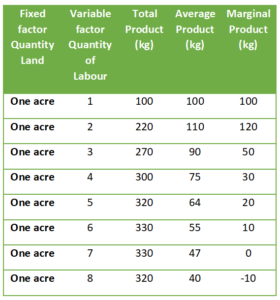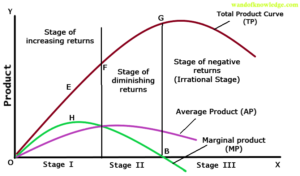Law of Variable Proportions
Law of Variable Proportions: Meaning and Definition
The costs of an individual firm are affected by two sets of considerations, named
- the proportions in which the firm combines factors, and
- the scale or which it operates. The law variable proportions deal with the first set and it is assumed that scale has no influence.
“As equal increments of one input are added” says Stigler, “the input of other productive services being held constant, beyond a certain point, the resulting increments of product will decrease, i.e., the marginal products with diminish.”
When the quantity of one factor is varied, keeping the quantity of other factors constant, the proportions between the variable factor and the fixed factor are altered. Hence it is called the law of variable proportions. It is also known the law of non-proportional output. It is the law of diminishing returns of classical economics which was stated by Marshall in the following words:
“An increase in the capital and labours applied in the cultivation land causes in general a less than proportionate increase in the amount produced, unless it happens to coincide with an improvement in the technique of agriculture.”
Assumption of the Law
The law of variable proportions holds true under the following assumptions:
- The state of technology is given. The various rates of input of the productive services are simultaneously available alternatives, and a historical sequence. This must be emphasized because for many decades after economists first adopted this law in 1815, its chief application was to the growth of population relative to land. Thus it was believed that diminishing returns would diminish technical progress. Economists no longer have this belief, and so hold constant state of technology.
- It is necessary that there are productive series whose quantity held constant. This law does not apply when all inputs are harmoniously variety at least in quite so simple a form; this is a problem of the economies of scale.
- The law premises the possibility of varying the proportions which the various productive services combine. Obviously, if two production services must be used in rigidly fixed proportions, an increase in one without a proportionate increase of the other will lead to no increase of output (marginal product will be zero, and not diminishing). For the law to operate, it is necessary that the proportions in which productive services combine generally be variable. The law is important and rigidly fixed proportions are quite uncommon.
Explanation of the Law
When one input is variable, the relation between the input and product are conventionally divided into three ‘stages’. In order to explain the three stages, we take the help to Table and Fig :-

It has been shown in the table that a farmer employs one labourer no one acre of land to produce, say, wheat. The total product from this piece of land is 100 kg of wheat. The average product and marginal product are the same in this case. When two labourers are employed, the land is utilised more effectively. Consequently, total product rises at an increasing rate and reaches 220 kg. The marginal product of the second labourer increases to 120kg and the average product of two workers goes up to 110 kg.
Two labourers fully utilise that piece of land. So, further increase in labourers applied to this plot of land results in the rise of total product but at a diminishing rate. Average product and marginal product begin to decline from the third unit of labour and continue to do so until the sixth unit of labour is employed. Total product is highest at this point. Seventh labour adds nothing to the total product, so its marginal product is zero. Addition of the eighth labour causes the total product to decline and the marginal product becomes negative.
The three stages have been presented in fig.
It can be seen in the figure that the total product curve rises at an increasing rate in the beginning and then ascends at a diminishing rate. It reaches its highest point at G and then begins to decline. The slope of TP curve is, DTP/DL, where L stand for labour. The slope of TP curve expresses marginal product. This slope is continuously changing. At point E its slope is the maximum because just below it at H, highest marginal product is obtained. E is known as the point of inflection. At point G the slope of TP curve is zero because here the marginal product reaches zero (at B).

Fig: Units of Labour Variable Factors
In stage I, marginal product increases first and then begins to decline. The boundary between stages 1 and stage II corresponds to the point where the average product is a maximum.
In stage II, marginal product continuously declines. The boundary between stage II and stage III is similarly marked by the maximum point on the total product curve, beyond which point the marginal product becomes negative.
In stage III, marginal product is negative and total product declines. It is an irrational stage as no producer can ever think to operate in this stage.
Stage is called the stage of increasing returns and stage II the stage of diminishing returns, while stage III is the stage of negative returns. In stage I, the marginal product of the fixed factor (here, land) is negative, while in stage III marginal product of the variable factor (here, labour) is negative.
Three Stages of the Law of Variable Proportions: Explanation
-
Stage-
In this stage the fixed factor is abundant relative to the variable factor. So when more units of the variable factor are added, the fixed factor is more intensively and effectively utilized. As a result, the marginal product of the variable factor increases in the beginning.
At this point a pertinent question is raised. Why is the fixed factor not initially taken in a quantity, which suits the available quantity of the variable factor? The answer is the “indivisibility” of the factor.
Individuality: It is the characteristic of a factor of production or commodity, which prevents its use below a certain minimum level. Many types of plant and machinery have, for engineering reasons, a single most efficient size. Consequently, it will be either technically impossible to make the equipment of a different size, or the costs of production associated with other sizes are higher. So as the scale of output increases up to this optimum, increasing productive efficiency is achieved.
-
Stage II-
It needs to be explained why diminishing returns appear in stage II.
Increasing returns appear in the first stage primarily because of the more effective and efficient use of the fixed factor as more and more units of the variable factor are combined to work with it (the fixed factor). Now once the point is reached at which the amount of the variable factor is sufficient to ensure the efficient utilization of the fixed factor, any further increases in the variable factor will cause the marginal and average products to decline. It will happen so because the fixed factor then becomes inadequate relative to the quantity of the variable factor.
In stage I, fixed factor is abundant relative to the units of the variable factor. In stage II, the fixed factor becomes scarce in relation to the variable factor. As a result, the increase in the units of the variable factor receives less and less aid from the fixed factor. So decline sets in average and marginal products.
-
Stage III-
In this stage, variable factor becomes abundant relative to the fixed factor. So even if some units of the variable factor are taken away, there would be no effect on production, or perhaps, total product will increase. Hence marginal product takes negative value. Although stage III is an irrational area of production, it is not uncommon for firms, lacking perfect knowledge, actually to produce in that region, particularly in agriculture.
Important links
- Law of Diminishing Returns- Definition, Causes, Limitation etc.
- Circumstances in which Demand Curve Slopes Upward
- Law of Demand- Definition, Chief Characteristics
- Importance of the Law of Diminishing Marginal Utility
- Elasticity of Demand- Definition, Degree, Measurement
- Price Elasticity- Factors & Importance
- Consumer Surplus- Definition, Measurement & Importance
- Production Function- Meaning, Explanation, Features, Types
Disclaimer: wandofknowledge.com is created only for the purpose of education and knowledge. For any queries, disclaimer is requested to kindly contact us. We assure you we will do our best. We do not support piracy. If in any way it violates the law or there is any problem, please mail us on wandofknowledge539@gmail.com
